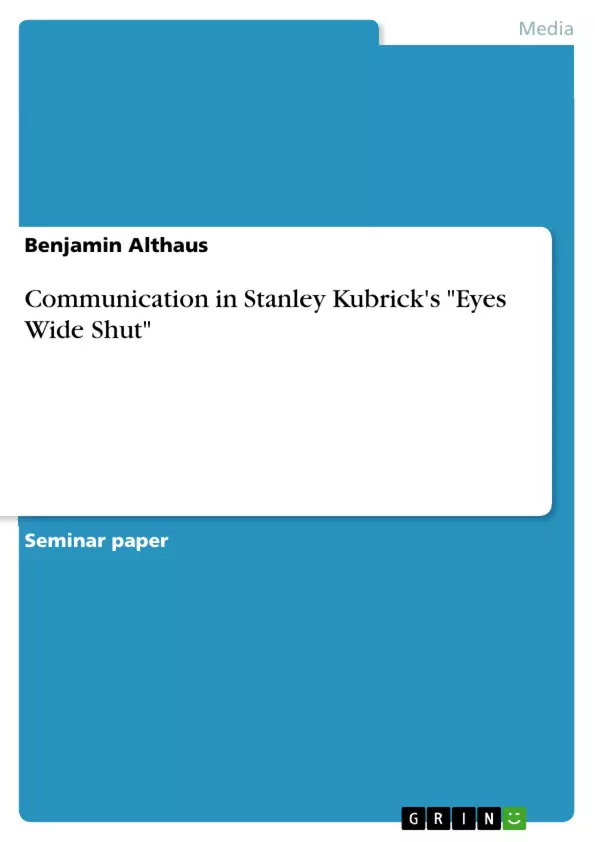Film has for a long time been neglected as an art: Sophisticated analysis has mainly been dealing with written literature as ‘the real thing’. In recent years the making of films has become more and more accepted as an art. Films are analysed and dealt with at universities and have become an essential part of school curricula. Nowadays cinematic theory is treated equally to written literature and “as a fully matured art, film is no longer a separate enterprise but an integrated pattern in the warp and woof of our culture” . In order to develop an ability to understand this art one has to learn to read its codes and interpret their meaning.
The following paper will deal with the role of communication in film and examine different levels on which filmic articulation takes place. Communication is an indispensable element for films, not only do characters communicate on the level of the plot but also the process of creating, showing and perceiving a film can be regarded as communication. It is this communication that allows the course of an action to be told and understood in the first place. A film is information, it is a message that is transmitted to a recipient, i.e. the audience. There are, however, problems to define who the sender of this message is. In Chapter 2 of this essay I will try to find a solution to this problem. Chapter 3 will put a focus on communication between the characters in this movie including some ways of non-verbal communication. Chapter 4 deals with a special way of communication which is a central point in Kubrick’s film: I will show how the unconscious can send messages to the conscious and how these messages can be interpreted.
A lot of parallels can be drawn between film and written literature. There are, however, some vital differences between the two genres. I will therefore make general comparisons between the language of books and that of cinema where it appears important and promotes understanding. I will apply examples from the movie “Eyes Wide Shut” (1999) by Stanley Kubrick to illustrate the theoretical approaches of my work. The main points of this paper are summarised in a conclusion in Chapter 5.
Table of Contents
- INTRODUCTION.
- HOW DOES FILM COMMUNICATE WITH THE AUDIENCE?
- The problem of defining a sender.
- Means of communication
- Metalanguage in film.…….…………….
- Symbolic meaning in film
- Characterization..
- How is characterisation realised in “Eyes Wide Shut”?
- HOW DO CHARACTERS COMMUNICATE WITH EACH OTHER?
- Verbal communication........
- Communicational disorders..
- Sexuality as a form of communication
- Body Language..
- HOW DOES THE UNCONSCIOUS MAKE ITSELF UNDERSTOOD?
- Alice's realistic dream.
- Bill's dreamlike reality
- Confronting the unconscious ..
- CONCLUSION
Objectives and Key Themes
This paper examines the role of communication in Stanley Kubrick’s film “Eyes Wide Shut”. The paper aims to explore the different levels of communication present in the film, examining the relationship between the film and its audience, the communication between characters, and the representation of the unconscious. This exploration will employ theoretical approaches and examples from the film.
- The communication between film and audience
- The representation of communication between characters, including verbal and nonverbal communication
- The role of the unconscious in communication
- The unique visual and narrative qualities of film
- Drawing parallels between film and written literature
Chapter Summaries
Chapter 2 focuses on the communication between film and audience, exploring how the film communicates its message. It analyzes the difficulty in defining a sender in film and explores the unique means of filmic communication, such as symbolic and technical codes. The chapter also examines how meaning is transmitted to the viewer and how cinematic codes are interpreted through an analysis of a bedroom-scene from the film.
Chapter 3 shifts the focus to communication between characters, analyzing verbal and non-verbal communication. It discusses various communication disorders and explores the theme of sexuality as a form of communication in the film. This chapter explores body language and its significance in conveying meaning.
Chapter 4 delves into the unique communication of the unconscious, exploring how the unconscious can send messages to the conscious in the film. It examines the distinction between Alice's realistic dream and Bill's dreamlike reality, highlighting the way both characters confront the unconscious.
Keywords
The primary focus of this paper is communication in film, with a particular emphasis on Stanley Kubrick’s "Eyes Wide Shut". Key themes and concepts include film theory, communication analysis, characterization, nonverbal communication, the unconscious, and the relationship between film and audience. The paper explores various theoretical approaches and methods for understanding communication in film, drawing parallels between film and written literature.
- Citar trabajo
- Benjamin Althaus (Autor), 2004, Communication in Stanley Kubrick's "Eyes Wide Shut", Múnich, GRIN Verlag, https://www.grin.com/document/31663



